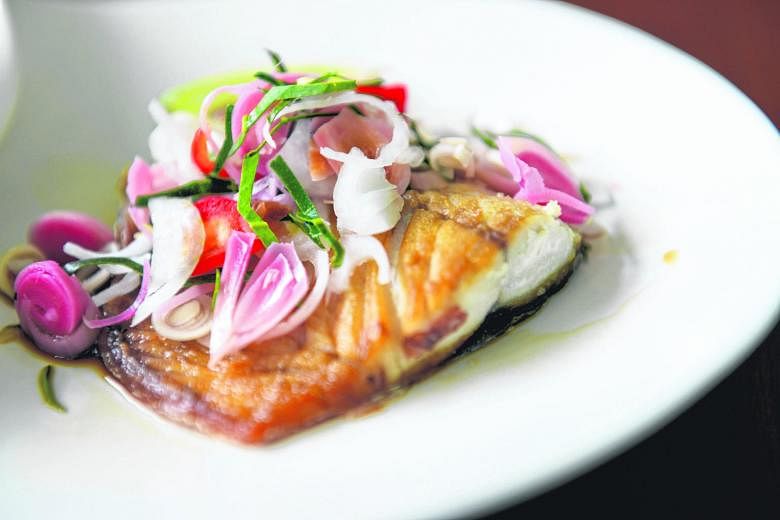It's that time of the year when I look for recipes that deliver maximum flavour but with less bulk and calories, after the mad feasting of recent months.
This recipe comprises a small piece of fish, sans bones and seared, topped with a herb topping that is left uncooked.
Since the herbs are left fresh, they make a lovely, sweet and aromatic topping for the fish.
Fish is always included in a healthy diet and the American Heart Association says you should eat fish at least twice a week.
I used Japanese mackerel or saba, because I like its rich, meaty flavour.
But next time, I will use a fish with a more subtle flavour, like a snapper.
Fish delivers lots of nutrients plus the important omega-3 fatty acids.
When you buy fish, pick one that is firm and glistening, with a mild odour that smells of the sea. You can get the fishmonger to debone the fish.
I served this seared fish with a small mound of brown rice and some greens, steamed or left raw as a salad.
I did not bother with a cooked sauce, but merely drizzled the fish with a light soya sauce and some lemon or lime juice before serving.
Amazingly, that was enough. But then, that is what we usually do with steamed fish. We serve it with a basic sauce, comprising just soya sauce and oil.
It is the herb topping that makes the dish interesting. This one relies on a couple of herbs commonly used in South-east Asian cuisine, and these are growing in my garden.
I picked kaffir lime leaves and torch ginger bud for the citrusy and floral fragrance, red chilli for spice and colour, and tiny shallots, sliced finely, for a sweet bite.
Aside from its fragrance, kaffir lime leaves are said to have a host of benefits, including improving digestion, lowering inflammation and reducing stress.
Torch ginger, on the other hand, is traditionally touted to help reduce inflammation and treat the loss of appetite, among other things.
Their colours help to beautify this dish as the fish would otherwise be served plainly seared.
And the good thing is that you do not need to cook the fish too long. A light sear, taking less than a minute on each side, would do.
Serve it with the flesh side up to bring out the pretty colours of the herbs.
•Sylvia Tan is a freelance writer and cookbook author. Her previous Eat To Live recipes can be found in two cookbooks, Eat To Live and Taste.
SEARED FISH WITH A FRESH HERB TOPPING
INGREDIENTS
1 torch ginger bud (bunga kantan), sliced finely
4 kaffir lime leaves, finely shredded
2 to 3 red chillies, sliced finely
3 to 4 shallots or small red onions, peeled and sliced finely
Two 100g pieces boneless saba or snapper fillets
1 tsp light soya sauce, or to taste
Juice from half a green lime
METHOD
1. Prepare the herb topping. Finely slice the torch ginger, kaffir lime leaves, red chilli and shallots.
Put aside.
2. Prepare the fish. If buying a whole fish, choose one with firm, shiny skin and pink gills. If buying fish steak, choose one with firm, translucent flesh.
3. Rub a little salt over the fish and rinse off. Dry with paper towel.
4. Heat a frying pan with a small amount of vegetable oil. When hot, sear the fish lightly, pressing down with a spatula one side at a time.
5. Remove fish and put on a plate.
6. Top with sliced fresh herbs.
7. Serve immediately with a drizzle of light soya sauce and a squeeze of lime juice.
8. If you want to add cooked vegetables, just wilt them in the already heated pan and serve with a bit of soya sauce.
SERVES TWO
Use kaffir lime leaves and torch ginger bud to spice up food
Torch ginger bud, or bunga kantan, is an edible flower commonly used in Asian dishes such as nonya laksa and Thai salads.
The leaves of the kaffir lime are often seen in Thai cooking, while the fruit is not used so much.
Both ingredients contain antioxidants and phytochemicals.
The leaves of the torch ginger have more antioxidants than the bud but it is less commonly used in cooking.
Although some online sites state the health benefits of these ingredients, none of these have been confirmed and it is not clear how much one has to consume in order to see any effects.
I would recommend using them as a "spice" to flavour your food, which might, in turn, help to reduce the need to use salt or sugar.
Due to the intense flavours of the torch ginger bud and kaffir lime leaves, this recipe calls for a limited amount of salt. This makes it a healthier choice.
You can add tomatoes if you want to increase your fibre intake. Cooked tomato releases lycopene, an antioxidant that may help to neutralise free radicals that harm our body cells.
If you want to make it even healthier, ensure that the vegetable oil does not contain any palm oil, hydrogenated oil or partially hydrogenated oils.
Choose oil that is low in saturated fat and high in mono- unsaturated fat, such as olive oil. And try using a lower-salt or sodium-light sauce with the Healthier Choice Symbol.
NUTRITIONAL INFORMATION (per serving - 150g)
Energy: 285kcal
Protein: 18g
Total fat: 21.9g
Saturated fat: 7.4g
Dietary fibre: 0.53g
Carbohydrate: 4.2g
Cholesterol: 34.5mg
Sodium: 309.8mg
•The above analysis excludes kaffir lime leaves and torch ginger bud as information on the two ingredients are not available.
Bibi Chia
Principal dietitian, Raffles Diabetes & Endocrine Centre

